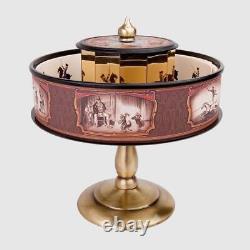Hemisferium Classic Praxinoscope H63


The Praxinoscope is one of the earliest forms of motion picture. It works in a very similar manner to a picture flip book, where a series of static images'flash' at frequencies that cause us to perceive them as a continuous moving image. The design of the Praxinoscope is deceptively simple; 12 brass mirrors mounted around a central column reflect a strip of printed paper towards the viewer. When the central frame is spun, each of these mirrors mounted on the cylindrical column break up the reflection of the paper strip into separate blinking images. The Praxinoscope was patented by the Frenchman Emile Reynaud in 1877, who was looking to overcome the deficiencies of the Zoetrope, which enjoyed enormous popularity at the time.
His apparatus was the first to eliminate the distorted view of the images in movement caused by insufficient light passing through the small slots of the Zoetrope. This improvement in the quality of the image resulted in immediate popularity for the Praxinoscope.
The Praxinoscope features a brass base and has eighteen individual paper strips featuring different images. The diameter of the drum is 20cm and the height of the Praxinoscope is 21cm.
